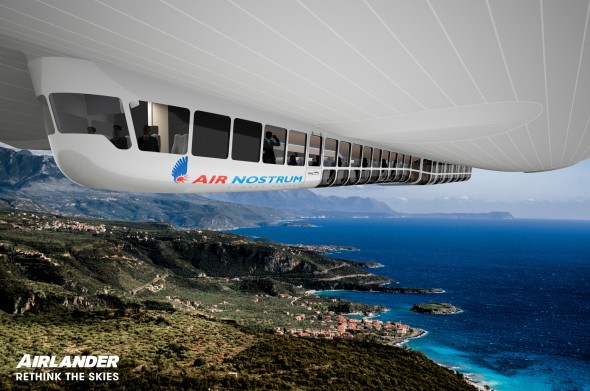NEWSLETTER
In Conversation: Holly Boyd-Boland, Virgin Atlantic


One of the more intriguing aviation sustainability initiatives that we’ve seen recently comes from UK-based airship company HAV.
Major media outlets share this interest in the company, with CNN, the Daily Mail, the BBC and Guardian covering the news that HAV has signed a deal with Spanish airline Air Nostrum for the purchase of ten “Airlander 10” aircraft.
HAV claims that the Airlander 10 airships, will reduce carbon emissions by 90% compared to regular aircraft along a similar route.
Note this is for an ‘hybrid-electric’ configuration, though even the base configuration with four combustion engines envisages a 75% reduction in environmental impact .
Air Nostrum says that it is intending to use the Airlander 10 on Spanish regional routes from 2026, when it is due to come into service.
So what’s the experience like?
First of all, flying in an airship will be much slower than normal. A Barcelona to Mallorca flight will take four hours, compared to 50 minutes as is currently the case.
Meanwhile the interior has a generous 1-2-1 configuration for 100 passengers, and an aircraft like this is obviously not suited for the high density configuration airlines are increasingly pushing for – see yesterday’s news that Airbus is looking at ways of jamming even more people into its aircraft.
As a result, the big question of course is how much an experience like this would cost, and would passengers be willing to pay for it?
HAV explicitly says on its website that the airships are meant for eco-tourism, and “experiential travel”, and this would be a pretty unique way to experience a flight across the mediterranean.
Is there a market for this? Almost certainly. Will it make much of a dent in the market of the LCCs currently accounting for much of the Mediterranean holiday traffic? Probably not.
As a result, this is an innovative offering, and one which may push the sustainability needle a little bit, without being one of the solutions that can be rolled out at scale.
In the latest episode of our ‘Sustainability in the Air’ podcast, ICCT Program Director, Dan Rutherford speaks with SimpliFlying CEO, Shashank Nigam, and dives deep into the future of sustainable aviation and the trajectory airlines and governments need to follow to get to net-zero emissions.
Rutherford terms the sustainability challenge as a “collective action problem” that needs to be tackled using a systems approach. Airlines and governments must work together to close the price gap between SAF and conventional jet fuels. These consultations are necessary since voluntary efforts from airlines simply wouldn’t suffice.
Mobilising consumers also plays a vital role in achieving the net-zero goals. With travel search engines like Google Flights and Kayak mapping out emission estimates by itinerary, consumers can make more conscious choices while planning their travel.
Positive story of the day
Nasa prepares first all-electric airplane for test flight (Independent)
Malaysia Aviation sustainability chief talks SAF opportunities in road to net-zero (Flight Global)
Sustainable Summer Travels in The Nordics (Travel Pulse)
Lilium Tweaks Its eVTOL Design for Short Running Landings (Flying Mag)
Neste: SAF delivered to New York using existing pipelines (Biodiesel Magazine)
Viva Aerobus Reveals Special Livery For First Sustainable Flight (Simple Flying)
Swedish Airports To Charge Airlines Based On CO2 Emissions (Simple Flying)
© 2022 SimpliFlying Pte. Ltd.